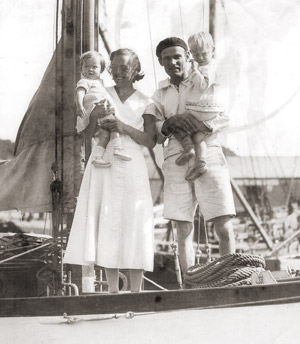A Family Album by Anna Dohm Nose Presentation to the SJHS Membership December 9, 2008
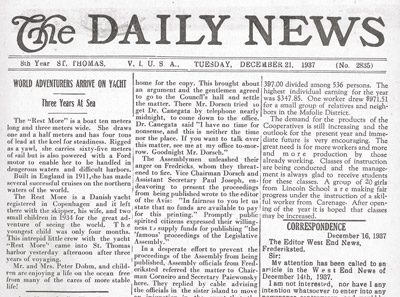
It was front page news on December 21, 1937, the local Daily News in fact, when Peter and Elsa Dohm and family arrived in their 10 meter yawl, Rest More, after a three year voyage. When the voyage began, Anna was four months old. Thus begins a family album covering the activities of this adventurous and entrepreneurial family. Luckily for us, this family believed in cameras and keepsakes, for Anna’s family album chronicles, with a small hiatus for the war years, the development of Cruz Bay and Red Hook from the 1930’s to the 1970’s.
This album of 90 or so photos and postcards have been posted on our website, thanks to Anna’s generosity. If you were lucky enough to attend her presentation, you will remember that Anna could name ALL the boats in the pictures— Victor Sewer’s Jolly Roger, the Boynes’ Johnny, the Chocolate Queen , Shadow X which brought groceries and passengers to St. John from Red Hook, Speed which brought the mail, the Baby Mac (which had no engine—one just sat in Mooie’s and waited—“the Baby Mac may be back,”), Alton Smith’s ferryboat Pollyanna, and the Santa Cruz, a World War I American Liberty ship used as the family’s houseboat, on which Anna lived for ten years. There are pictures of Tortola sloops, overloaded with beach-harvested sand, ballast and other goods, loaded to within inches of the gunnels, making you wonder why more of them didn’t sink in ‘The Graveyard’, the open water between Red Hook and the St. James islands.
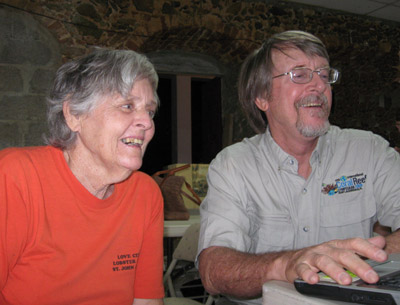
Presenter Anna Dohm Nose and Board Member Rafe Boulon,
who scanned the photo album for presentation,
review the porfolio of island memories.
For another glimpse of Anna’s father, Peter Dohm, during the ‘war years’, when he was ‘interned’ in the U.S. because of his German ancestry, and his family was back in Denmark, read Caribbean Cruise, by Kate and Richard Bertram, published in 1948 by WW Norton Co. Their descriptions of clear-watered Cruz Bay, Peter’s sloop Talofa and its tender, “an overgrown cheese carton,” and dinner ashore at Miss Keating’s top off a great set of stories about living aboard in Charlotte Amalie Harbor at Mud Hole behind a submarine net.
One forgets how much Red Hook, and St. Thomas in general, has been reengineered. Her photo album depicts a once-tiny spit of land on which the Red Hook dock and Mama Dohm’s waiting room sat. That spit of land, the Sapphire Bay beach, and the Red Hook Park dock are abutted by huge saltponds, now filled in with dredged material harvested from Red Hook bay. Instead of houses and radio towers, large paved catchment areas adorn the hillsides above Charlotte Amalie.
Anna described those days when you started a business to fill a niche, like a haulout and boat repair business with a marine railway, or a gas station/hot sandwich shop, or you could build a dock, (no permits required), or you ran a water taxi business—all things her family did over a 60 year tenancy in the Virgin Islands.
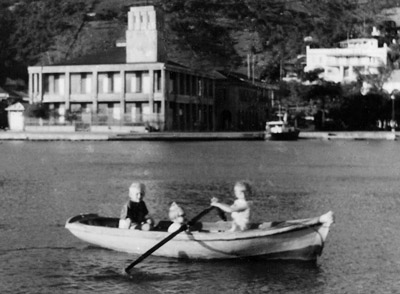
Anna with Lars and a friend at King’s Wharf
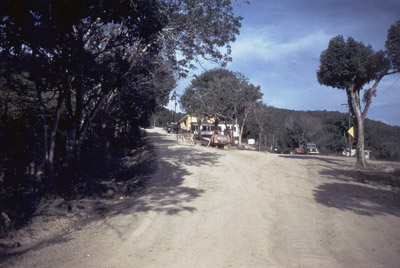
South Side Road and Centerline Road ‘Y’ intersection
— before the Texaco Station arrived, ca 1960
The St. John landscape has changed as well, but somehow not as drastically as Red Hook’s environs. The album shows an earlier era, in the 50’s and 60’s, when you could drive out onto the Cruz Bay ferry dock to load your St. Thomas goods (but, says the sign, only after passengers have debarked).
The album shows that spider crabs were caught in the bay, the Lobster Hut was where Morgan’s Mango is now. Swimming in the bay with a mask, Anna reported, (snorkels came later) could be followed by good food at Miss Meada’s or a stroll down Peacock Lane. The easy familiarity with everyone you met in Cruz Bay made St. John a special home.
Thank you, Anna, for sharing these island memories with us.
(To view the entire album, visit this photograph collection)

